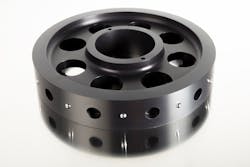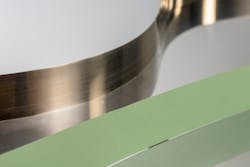At a Glance:
- Metal belts are strong. Multi-layer metal belts are stronger.
- Metal resists scratches and nicks, giving bacteria no place to hide and breed.
- Metal belts create no dust or debris.
Single-layer metal belts are stronger than plastics or rubber belts. But they can still lack the strength and durability to handle applications involving heavy lifting and repetitive motions, such as robotics. In these cases, multi-layered metal belts are a better choice.
But are multi-layered metal belts a good choice for your design or application?
Here’s a look at the advantages and disadvantages of multi-layered metal belts compared to their single-layer counterparts and non-metal belts.
Metal Belt Basics
Multi-layered belts are similar to single-layer belts in design, and both can be used in endless or open configurations.
An endless metal belt is a single continuous sheet of metal welded together into a loop. Such a belt is durable and provides consistent, repeatable performance, making it useful in automated assembly, food processing and medical devices.
Metal drive tapes, on the other hand, are set up in open configurations. They share metal construction with belts but are anchored at each end. They are commonly used for extremely accurate and repeatable motion, which is necessary in making 3D printers and robots.
Metal belts can be made from a variety of stainless steel and titanium alloys, as well as nickel alloys such as Inconel and Invar. Some of these materials resist low temperatures, others resist corrosion, and some have high tensile and yield strengths. The material choice depends on the intended application.
Much like their single-layer counterparts, multi-layered drive tapes offer zero backlash, which occurs as the result of too much clearance between the timing belt’s holes and the pulley’s timing pin. Some clearance is generally needed to avoid interference and let the pins fit into holes, but it can cause backlash when the belt is reversed.
When the pulley turns to move the belt backwards the pins must first move from one side of their holes to the other before they push the belt. This small backlash can inject positional inaccuracies into the motion profile. Precision metal belts can be designed to eliminate this.
Multi-Belt Differences
Multi-layered belts consist of 2-7 stacked bands ranging in thickness from 0.003 to 0.005 in. This minimizes the overall stress put on the belt and lets the belt carry a larger tensile load across its increased cross-sectional area. The added strength also lengthens the belts operational life.
The layered construction also adds stiffness, which increases its modulus of elasticity so the belt can resist backlash due to any remaining gaps between the timing holes and pins that cannot be engineered out. This can be helpful in many applications. For example, some robotic arms have two steel belts working in tandem with one belt driving the reversing motion. Thanks to the steel belt’s inelasticity, this design can handle rapid acceleration and reversing without causing backlash. Multi-layered belts are typically used this way to handle high loads and accelerations.
Multi-layered belts are more difficult to make due to all the layers that must be precisely manufactured and then welded together at the belt’s end tab. Each belt layer has a slightly different length and must be attached so it can fit with the other layers when wrapped around the pulley. The end tab is another key element to ensuring a long belt life because it is exposed to high levels to stress. Because of this, the design of the tab is as important as the high-quality, precision welding used to create it.
Multi-layered belts offer many advantages, including their strength and flexibility, but they have several others.
Belt thickness and pulley size determine the belt’s lifespan. A larger pulley generally means a belt can carry a larger load. But multi-layered belts can carry high load without having to increase the pulley’s diameter. The multiple levels provide the strength of a thicker band but work together to have the flexibility of a smaller band. Applications that take full advantage of multi-layer metal belts involve moving heavy loads without the space for a properly sized pulley needed for a single-layered but thicker belt. This design can accommodate pulley diameters as small as 1.5 in.
As previously stated, multi-layered metal belts are more difficult to produce, which leads to a higher initial cost. This is a disadvantage upfront, but these belts are more cost-effective over their lifespan due to their increased durability.
Compared to traditional non-meal belts, multi-layered metal belts’ longer life and lower cleaning and maintenance requirements help offset the upfront cost and make them a better option in the long run.
Metal belts can be deformed beyond repair when improperly used or subject to major impacts. Keeping metal belts, single- or multi-layered, safe from this type of damage is key to ensuring a belt long life.
Multi-Layered Metal Belts in Action
A firm was trying to get new technologies proven and commercialized for robotic applications. The projects included new ways to lift and rotate heavy loads in the warehousing, logistics, medical and food processing fields.
The firm worked on one machine that used a single-layer metal belt made from locally sourced metal. The belt measured 6 mm wide by 0.2 mm thick, but it was failing when the torque on belt exceeded 25 Nm. The client then worked with an engineering team from Belt Technologies.
One of the challenges was that they could not change the pulley diameter. So, the team designed and manufactured a stainless-steel belt with six layers, each 0.125 mm thick. It let the machine carry handle the required 150 Nm of torque without increasing the bending stress. Consequently, overall stresses on the belt reduced, increasing its life.
The firm saw the success of the belt prototype, which was mainly used for demonstrations, and ordered versions of the new metal belts with slightly modified lengths for use in healthcare devices.
Speaking of healthcare applications, metal belts let medical device makers meet safety regulations for motor-driven conveyer belts in pharmaceutical and medical applications. Metal belts, unlike plastic or rubber versions resist bacteria that could corrupt pharmaceuticals. They are also more sanitary by virtue of being easier to clean and water/detergent resistant.
Multi-layered metal belts finding a niche in robotics. Open configuration metal drive tapes, a type of multi-layer belt, can perform many tasks with near-zero backlash, including:
- Positioning carriages
- Moving robotic arms
- Making LCDs
- Optical element drives
Are They Right for You?
In addition to better strength and flexibility than single-layer belts, multi-layered belts have all the features and benefits of other all-metal belts, including:
- High strength-to-weight ratios
- Durability and longer belt life than alternatives
- Rigid (non-stretchable) for increased precision
- Resist fluctuating temperatures
- Resist corrosion, rust and overheating
In addition, they:
- Require no lubrication
- Conform to the most stringent USDA requirements for food production
- Allow for high accuracy and repeatability
- Are nonporous and resist surface damage
- Are highly customizable to suit varied industries and applications
- Don’t generate particles like HTD or flat neoprene belts, making them well-suited for cleanroom applications.
Denis Gagnon is CEO and Alan Wosky is president of Belt Technologies Inc. in Agawam, Mass. Contact them here.





